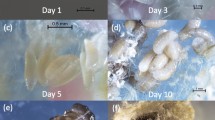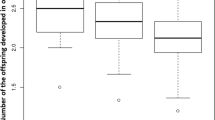Abstract
Anaphes nitens is a solitary parasitoid of the egg capsules of the Eucalyptus snout beetle, Gonipterus scutellatus. Some traits of its natural history suggest that Local Mate Competition (LMC) could account for sex ratio adjustment in this species. We tested whether males emerged early, a prerequisite for fully local mating, and investigated the occurrence and effect of superparasitism on adult size and pre-emergence mortality, factors that might influence sex ratio adjustment. We found in field-collected egg capsules that males emerged first. To investigate the effects of superparasitism on adult size, we compared the sizes of parasitoids that emerged early and late from egg capsules collected in the field, and from egg capsules parasitized and superparasitized in the laboratory. Superparasitism reduced parasitoid size, affecting females more strongly than males, and increased pre-emergence mortality. We estimated A. nitens sex ratio and parasitism rate in the field during 2 years in five localities and during 4 years in a sixth. Following LMC we expected an increase in sex ratio (proportion of males) with increasing parasitism rate (assumed to reflect parasitoid density). We found that sex ratio decreased from 0.38 when the parasitism rate was low (0–20%) to 0.21 when parasitism was high (80–100%). In contrast with field results, a laboratory experiment showed that: (1) at a low parasitism level sex ratio was clearly female biased (0.28±0.04), (2) at a high parasitism level sex ratio increased (0.40±0.07), (3) male larval survivorship was not lower than female survivorship, and (4) low-quality hosts (i.e. superparasitized) were allocated more males. We conclude that LMC cannot explain the sex ratio adjustment observed in the field, even at low parasitism rates, and alternative explications for highly female-biased sex ratios must be found. One such alternative is female-biased dispersal.




Similar content being viewed by others
References
Alphen JJ van, Visser ME (1990) Superparasitism as an adaptive strategy for insect parasitoids. Annu Rev Entomol 35:59–79
Anderson RC, Paschke JD (1969) Additional observations on the biology of Anaphes flavipes (Hymenoptera: Mymaridae), with special reference to the effects of the temperature and superparasitism on development. Ann Entomol Soc Am 62:1316–1321
Antolin MF (1993) Genetics of biased sex ratios in subdivided populations: models, assumptions, and evidence. Oxford Surv Evol Biol 9:239–281
Antolin MF, Strong DR (1987) Long-distance dispersal by a parasitoid ( Anagrus delicatus,Mymaridae) and its host. Oecologia 73:288–292
Antolin MF, Ode PJ, Strand MR (1995) Variable sex ratios and ovicide in an outbreeding parasitic wasp. Anim Behav 49:589–600
Arzone A, Vidano C (1978) Introduzione in Italia di Patasson nitens, parassita di un nuovo nemico dell'Eucalipto. Inf Agrario 34:2741–2744
Assem J van den, van Iersel JJA, Los-den Hartogh RL (1989) Is being large more important for female than for male parasitic wasps? Behaviour 108:160–195
Baaren J van, Boivin G, Le Lannic J, Nénon J-P (1997) The male and female first instar larvae of Anaphes victus and A. listronotus (Hymenoptera, Mymaridae). Zoomorphology 117:189–197
Baaren J van, Landry BL, Boivin G (1999) Sex allocation and larval competition in a superparasitizing solitary egg parasitoid: competing strategies for an optimal sex ratio. Funct Ecol 13:66–71
Charnov (1981)
Cordero Rivera A, Santolamazza Carbone S, Andrés JA (1999) Life cycle and biological control of the Eucalyptus snout beetle (Coleoptera, Curculionidae) by Anaphes nitens (Hymenoptera, Mymaridae) in north-west Spain. Agric For Entomol 1:103–109
Crawley MJ (1993) GLIM for ecologists. Blackwell Science, Oxford
Cronin JT, Strong DR (1993) Substantially submaximal oviposition rates by a mymarid egg parasitoid in the laboratory and field. Ecology 74:1813–1825
Dijken MJ van, van Alphen JJM (1991) Mutual interference and superparasitism in the solitary parasitoid Epidinocarsis lopezi . Med Fac Landbouww Rijksuniv Gent 56(3b):1003–1010
Dijken M van, Waage JK (1987) Self and conspecific superparasitism by the egg parasitoid Trichogramma evanescens. Entomol Exp Appl 43:183–192
Ellers J, van Alphen JJM, Sevenster JG (1998) A field study of size-fitness relationships in the parasitoid Asobara tabida. J Anim Ecol 67:318–324
Fisher RC (1930) The genetical theory of natural selection. Oxford University Press, Oxford
GenStat (2000) GenStat for Windows. Release 4.2. Fifth edition. VSN International, Oxford
Godfray HCJ (1990) The causes and the consequences of constrained sex allocation in haplodiploid animals. J Evol Biol 3:3–17
Godfray HCJ (1994) Parasitoids. Behavioral and evolutionary ecology. Princeton University Press, Princeton, N.J.
Godfray HCJ, Cook JM (1997) Mating systems of parasitoid wasps. In: Choe JC, Crespi BJ (eds) The evolution of mating systems in insects and arachnids. Cambridge University Press, Cambridge, pp 211–225
Godfray HCJ, Müller CB (1998) Host-parasitoid dynamics. In: Dempster JP, McLean IFG (eds) Insect populations. Kluwer Academic Publisher, Dordrecht, pp 135–165
Hamilton WD (1967) Extraordinary sex ratios. Science 156:477–488
Hanks LM, Millar JG, Paine TD, Campbell CD (2000) Classical biological control of the Australian weevil Gonipterus scutellatus (Coleoptera: Curculionidae) in California. Biol Contr 29:369–375
Hardy ICW (1994) Sex ratio and mating structure in the parasitoid Hymenoptera. Oikos 69:3–20
Hardy ICW, Dijkstra LJ, Gillies JEM, Luft PA (1998) Patterns of sex ratio, virginity and developmental mortality in gregarious parasitoids. Biol J Linn Soc 64:239–270
Harvey JA, Harvey IF, Thompson DJ (1993) The effect of superparasitism on development of the solitary parasitoid wasp, Venturia canescens (Hymenoptera: Ichneumonidae). Ecol Entomol 18:203–208
Hassell MP (2000) The spatial and temporal dynamics of host-parasitoid interactions. Oxford University Press, Oxford
Heinz KM (1996) Host size selection and sex allocation behaviour among parasitoid trophic levels. Ecol Entomol 21:218–226
Huber JT, Prinsloo GL (1990) Redescription of Anaphes nitens (Girault) and description of two new species of Anaphes Haliday (Hymenoptera; Mymaridae), parasites of Gonipterus scutellatus Gyllenhal (Coleoptera: Curculionidae) in Tasmania (Australia). J Aust Entomol Soc 29:333–341
Hurlbutt B (1987) Sexual size dimorphism in parasitoid wasp. Biol J Linn Soc 30:63–89
Kidd NAC, Jervis MA (1997) The impact of parasitoids and predators on forest insect populations. In: Watt AD, Stork NE, Hunter MD (eds) Forests and insects. Chapman and Hall, London, pp 49–68
King BH (1987) Offspring sex ratios in parasitoid wasps. Q Rev Biol 62:367–395
King BH (1996) Sex ratio responses to other parasitoid wasps: multiple adaptive explanations. Behav Ecol Sociobiol 39:367–374
Liebhold AM (2000) Are population cycles and spatial synchrony a universal characteristic of forest insect populations? Popul Ecol 42:205–209
Mackauer M, Bai B, Chow A, Danyk T (1992) Asymmetric larval competition between two species of solitary parasitoid wasps: the influence of superparasitism. Ecol Entomol 17:233–236
Mansilla JP, Pérez Otero R (1996) El defoliador del eucalipto Gonipterus scutellatus. Phytoma España 81:36–42
Mossop MC (1929) Mymarid parasite of the eucalyptus snout-beetle. Sci Bull Dep Agric For S Afr 81:1–19
Nénon J-P, Boivin G, Le Lannic J, van Baaren J (1995) Functional morphology of the mymariform and sacciform larvae of the egg parasitoid Anaphes victus Huber (Hymenoptera: Mymaridae). Can J Zool 73:996–1000
Ode PJ, Antolin MF, Strand MR (1998) Differencial dispersal and female-biased sex allocation in a parasitic wasp. Ecol Entomol 23:314–318
Potting RPJ, Snellen HM, Vet LEM (1997) Fitness consequences of superparasitism and mechanism of host discrimination in the stemborer parasitoid Cotesia flavipes. Entomol Exp Appl 82:341–348
Santolamazza Carbone S (2002) Ecología del comportamiento del gorgojo del eucalipto Gonipterus scutellatus Gyllenhal y de su parasitoide Anaphes nitens Girault. PhD dissertation. Universidade de Vigo, Spain
Santolamazza Carbone S, Cordero Rivera A (2003) Egg load and adaptive superparasitism in Anaphes nitens, an egg parasitoid of the Eucalyptus snout-beetle Gonipterus scutellatus. Entomol Exp Appl 106:127–134
Santolamazza Carbone S, Rodríguez Illamola A, Cordero Rivera A (2003) Host finding and host discrimination ability in Anaphes nitens Girault, an egg parasitoid of the Eucalyptus snout-beetle Gonipterus scutellatus Gyllenhal. Biol Control (in press)
Stouthamer R, Hurst GDD, Breeuwer JAJ (2002) Sex ratio distorters and their detection. In: Hardy ICW (ed) Sex ratios. Concepts and research methods. Cambridge University Press, Cambridge, pp 195–215
Strand MR, Pech LL (1995) Immunological basis for compatibility in parasitoid-host relationships. Annu Rev Entomol 40:31–56
Tooke FGC (1955) The Eucalyptus snout-beetle, Gonipterus scutellatus Gyll. A study of its ecology and control by biological means. Entomol Mem Dept Agric S Afr 3:1–282
Vidano C, Arzone A, Meotto F (1979) Moltiplicazione e disseminazione in Italia di Patasson nitens per la difesa degli eucalipti da Gonipterus scutellatus. Ann Acad Agric Torino 121:99–113
Vinson SB (1980) Host suitability for insect parasitoid. Annu Rev Entomol 25:397–419
Vinson SB, Hegazi EM (1998) A possible mechanism for the physiological suppression of conspecific eggs and larvae following superparasitism by solitary endoparasitoids. J Insect Physiol 44:703–712
Visser ME (1995) The effect of competition on oviposition decisions of Leptopilina heterotoma (Hymenoptera: Eucoilidae). Anim Behav 49:1677–1687
Visser ME, Driessen G (1991) Indirect mutual interference in parasitoids. Neth J Zool 41:214–227
Visser ME, van Alphen JJ, Nell HW (1990) Adaptive superparasitism and patch time allocation in solitary parasitoids: the influence of the number of parasitoids depleting a patch. Behaviour 114:21–36
Visser ME, Luyckx HW, Boskamp GJF (1992a) Adaptive superparasitism in solitary parasitoids: marking of parasitized hosts in relation to the pay-off from superparasitism. Ecol Entomol 17:76–82
Visser ME, van Alphen JJM, Hemerik L (1992b) Adaptive superparasitism and patch time allocation in solitary parasitoid: an ESS model. J Anim Ecol 61:93–101
Waage JK (1986) Family planning in parasitoids: adaptive patterns of progeny and sex allocation. In: Waage JK, Greathead DJ (eds) Insect parasitoids. Academic Press, London, pp 63–96
Wellings PW, Morton R, Hart PJ (1986) Primary sex-ratio and differential progeny survivorship in a solitary haplo-diploid parasitoids. Ecol Entomol 11:341–348
Werren JH (1980) Sex ratio adaptations to local mate competition in a parasitic wasp. Science 208:1157–1159
Williams JR, Moutia LA, Hermelin PR (1951) The biological control of Gonipterus scutellatus Gyll. (Col. Curculionidae) in Mauritius. Bull Entomol Res 42:23–28
Acknowledgements
We are grateful to David J. Thompson for his revision of English on a previous version of this manuscript. Funding was provided by the Spanish Ministry of Education and Culture as a doctoral grant to SSC, and as research grants to ACR (DGES PB97–0379) and Cátedra Filgueira Valverde, Universidade de Vigo.
Author information
Authors and Affiliations
Corresponding author
Rights and permissions
About this article
Cite this article
Santolamazza-Carbone, S., Cordero Rivera, A. Superparasitism and sex ratio adjustment in a wasp parasitoid: results at variance with Local Mate Competition?. Oecologia 136, 365–373 (2003). https://doi.org/10.1007/s00442-003-1269-5
Received:
Accepted:
Published:
Issue Date:
DOI: https://doi.org/10.1007/s00442-003-1269-5




